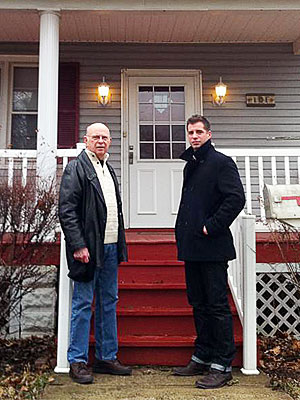
Last year, Chris Thompson, a 29-year-old IT consultant based in the south suburbs, told his grandfather, Don Clinkert, he was thinking of getting in on the foreclosure-to-rental investment scene. Clinkert said he’d been considering doing the same. Now the two are 50-50 partners as landlords on a house they bought in Steger for $45,250, with tenants moving in February 1.
“The interest rates on CDs and the various safe havens out there are about 0.5 percent,” says Clinkert, a 74-year-old retired insurance executive. “[House] prices and [mortgage] interest rates are so low that it’s a good opportunity for Christopher and for me.” Thompson’s calculations suggest the partners will reap up to 20 percent profit a year, depending on how much is siphoned off by unexpected expenses for repairs.
Thompson and Clinkert have been strategic about their choices along the way and their experience may be instructive for other first-time investors. Here’s what they did:
• Thompson attended a seminar taught by Bruce Hackel, a south suburban ReMax agent whose family has a real estate portfolio. One of Hackel’s key tips is: “Don’t buy a rental property more than 15 minutes away from your house—at least initially. You’re going to have to stop in and check on it, collect the rent, so don’t make it a destination or you won’t be an effective property manager.” With that in mind, Thompson, who lives in Steger, started looking for properties there and in nearby Chicago Heights.
• Thompson devised his own form of market research. When he found a house that might work, he created a bogus rental ad and put it on Craigslist to gauge interest. He likens it to consumer brands surveying a test audience—and says that he told respondents what was going on and offered to keep their names on hand.
• Thompson and Clinkert settled on a 1,600-square-foot three-bedroom house in Steger that, although it wasn’t a foreclosure, was bargain-priced. Sold in 2009 for $103,000, it was priced at $59,900 when Thompson found it in October. (The reason for the low price is unclear; the house was owned by a limited liability company, according to the Will County Recorder of Deeds.) The house needed a new water heater, two new toilets, a bathroom door, and some other minor repairs, most of which the partners were able to do on their own. They estimate they spent about $1,500, for a total investment of $46,750.
• They set the rent based on the going rates for nearby rentals. At Steger’s New Colonies apartments, a three-bedroom unit had a monthly rent of $1,150. Thompson set the house’s rent at $1,200, reasoning “the chance to have your own house, yard, and garage would make it worth the extra $50.” He was right: An ad went up on a Sunday, and by the following Thursday, Thompson had received more than a dozen calls. The tenant he signed was one of the respondents from his bogus ad, a single mother of two. (She will move in February 1.) In addition to a steady job and a stable rental history, she also has a Section 8 voucher, which the partners think reduces the risk of nonpayment by the tenant.
• At $1,200 a month, the rental income is about 20 percent above the partners’ monthly expenses on the house, which includes mortgage payments, insurance, and property taxes (which they successfully appealed for a $2,400-a-year reduction based on the home’s value).
Granted, the project has only begun, and the pair hasn’t been subjected yet to midnight calls from a tenant, but so far they feel confident. Clinkert says that he may form similar partnerships with some of his other grandchildren—“all except the three year old.”



